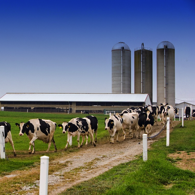Evaluation of microclimate in dairy farms using different model typologies in computational fluid dynamics analyses

Published: 9 July 2024
Abstract Views: 270
PDF: 155
HTML: 3
HTML: 3
Publisher's note
All claims expressed in this article are solely those of the authors and do not necessarily represent those of their affiliated organizations, or those of the publisher, the editors and the reviewers. Any product that may be evaluated in this article or claim that may be made by its manufacturer is not guaranteed or endorsed by the publisher.
All claims expressed in this article are solely those of the authors and do not necessarily represent those of their affiliated organizations, or those of the publisher, the editors and the reviewers. Any product that may be evaluated in this article or claim that may be made by its manufacturer is not guaranteed or endorsed by the publisher.
Similar Articles
- Alessandro D'Emilio, Simona M.C. Porto, Giovanni Cascone, Marco Bella, Marco Gulino, Mitigating heat stress of dairy cows bred in a free-stall barn by sprinkler systems coupled with forced ventilation , Journal of Agricultural Engineering: Vol. 48 No. 4 (2017)
- Daniela Lovarelli, Elisabetta Riva, Gabriele Mattachini, Marcella Guarino, Giorgio Provolo, Assessing the effect of barns structures and environmental conditions in dairy cattle farms monitored in Northern Italy , Journal of Agricultural Engineering: Vol. 52 No. 4 (2021)
- Francisco Ayuga, Present and future of the numerical methods in buildings and infrastructures areas of biosystems engineering , Journal of Agricultural Engineering: Vol. 46 No. 1 (2015)
- Carlos Alejandro Perez Garcia, Marco Bovo, Daniele Torreggiani, Patrizia Tassinari, Stefano Benni, 3D numerical modelling of temperature and humidity index distribution in livestock structures: a cattle-barn case study , Journal of Agricultural Engineering: Vol. 54 No. 3 (2023)
- Shahad Al-Rikabi, Enrica Santolini, Beatrice Pulvirenti, Marco Bovo, Alberto Barbaresi, Daniele Torreggiani, Patrizia Tassinari, Definition of thermal comfort of crops within naturally ventilated greenhouses , Journal of Agricultural Engineering: Vol. 54 No. 4 (2023)
- Simona M.C. Porto, Alessandro D'Emilio, Giovanni Cascone, On the influence of the alternation of two different cooling systems on dairy cow daily activities , Journal of Agricultural Engineering: Vol. 48 No. 1 (2017)
- Alexandros Sotirios Anifantis, Simone Pascuzzi, Giacomo Scarascia-Mugnozza, Geothermal source heat pump performance for a greenhouse heating system: an experimental study , Journal of Agricultural Engineering: Vol. 47 No. 3 (2016)
- George Ashwehmbom Looh, Fangping Xie, Xiushan Wang, Augustine Ngiejungbwen Looh, Hamdaoui Hind, Grain kernel damage during threshing: a comprehensive review of theories and models , Journal of Agricultural Engineering: Vol. 56 No. 1 (2025)
- Vincenzo Bagarello, Vito Ferro, Dennis Flanagan, Predicting plot soil loss by empirical and process-oriented approaches. A review , Journal of Agricultural Engineering: Vol. 49 No. 1 (2018)
- Hui Yang, Yuhao Li, Chengguo Fu, Rongxian Zhang, Haibo Li, Yipeng Feng, Yaqi Zhang, Hongbin Cong, Fuquan Nie, Research on inspection route of hanging environmental robot based on computational fluid dynamics , Journal of Agricultural Engineering: Vol. 55 No. 2 (2024)
You may also start an advanced similarity search for this article.

 https://doi.org/10.4081/jae.2024.1589
https://doi.org/10.4081/jae.2024.1589 











